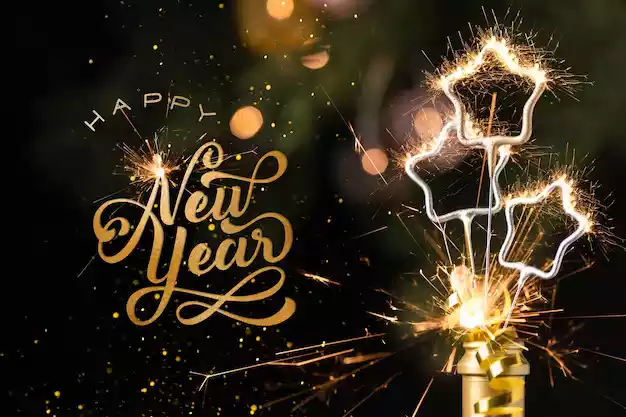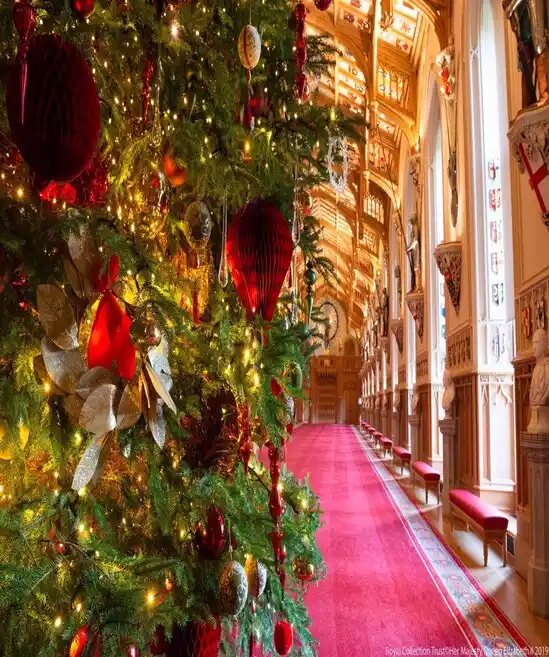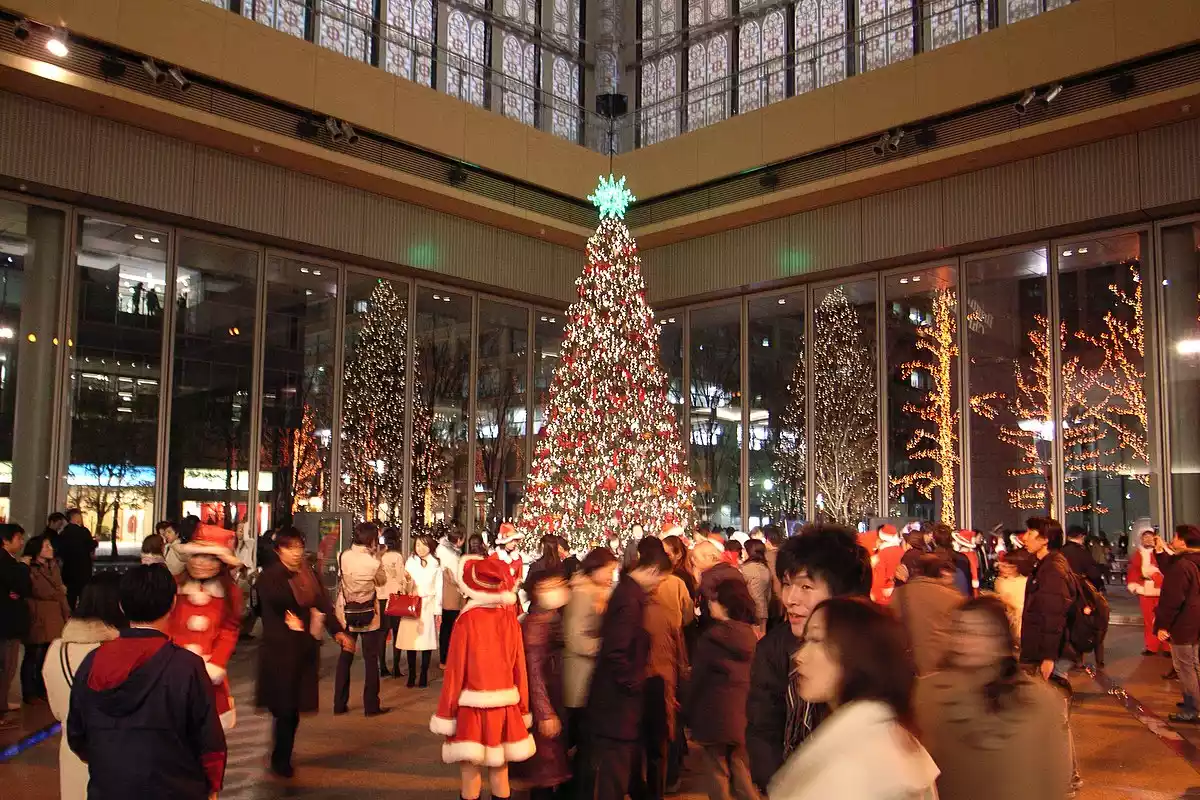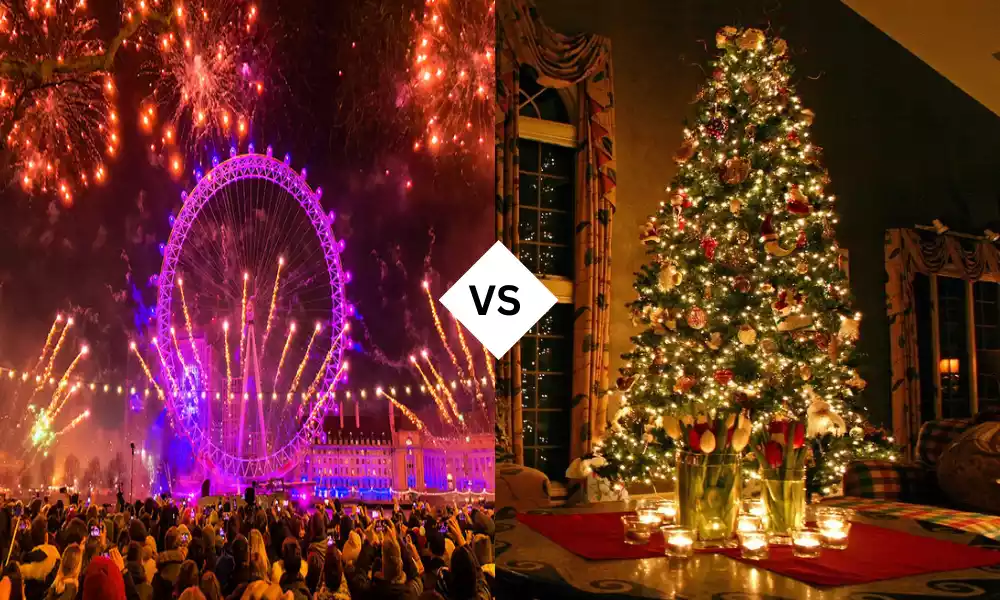Introduction of New Year and Christmas
The festive season is marked by joy, unity, and the spirit of giving and receiving. Two of the most celebrated holidays around the world are New Year’s Day and Christmas. While they might seem closely related because of their proximity on the calendar, each has distinct origins, significance, and ways of celebration. This article delves into the differences between the two, while also shedding light on their similarities.
What is New Year?
New Year signifies the beginning of a new calendar year. It is a universal event, celebrated in different ways across various cultures and religions, but it predominantly marks a fresh start, the renewal of hopes, and the setting of new goals. Depending on the calendar in use – Gregorian, Lunar, or others – the date of the New Year varies, but January 1st is the most widely recognized date.<
 New Year[/caption]
New Year[/caption]
What is Christmas?
Christmas is a Christian holiday that commemorates the birth of Jesus Christ. Celebrated on December 25th by billions, it carries both religious significance for Christians and cultural importance for many others. The festivities are often characterized by church services, feasting, and the exchange of gifts.

Historical Origins of New Year and Christmas
New Year: Historically, ancient cultures would mark the New Year based on astronomical or agricultural events. For example, the Babylonians began their New Year with the first new moon after the vernal equinox. The idea of January 1st as the start of the New Year was established by the Roman calendar, which was later reformed into the Gregorian calendar used by most of the world today.
Christmas: The exact date of Jesus’s birth is unknown, and December 25th wasn’t adopted until the 4th century by the Roman Church. It’s believed that the date was chosen to align with pagan festivals. The Winter Solstice, Saturnalia (a Roman festival), and the birthday of the sun god, Mithra, were all celebrated around this time.
Significance of New Year and Christmas
The significance of both New Year and Christmas is deeply rooted in history, religious beliefs, and cultural practices. These occasions have evolved over the years, and their relevance today is a mix of spiritual, traditional, and modern interpretations. Let’s delve deeper into the importance of both events.
New Year:
- Symbol of Renewal and Fresh Beginnings: The New Year represents the start of a new calendar cycle. It’s a universal symbol of renewal, offering everyone a chance to begin afresh, let go of past regrets, and make new resolutions. It’s the proverbial “clean slate.”
- Time of Reflection: As the year draws to a close, it’s common for people to introspect on the past year’s achievements, failures, and memorable moments. It’s a period of self-assessment which aids in setting goals and aspirations for the coming year.
- Hopes and Wishes: New Year is synonymous with hope. People worldwide express wishes of prosperity, health, and happiness for their loved ones. This optimism for a better future is a uniting factor across cultures.
- Cultural and Religious Observances: While January 1st is the start of the Gregorian calendar year, many cultures and religions have their own New Year celebrations based on different calendars. For instance, the Chinese Lunar New Year and the Jewish Rosh Hashanah are deeply ingrained with specific cultural and religious practices and meanings.
Christmas:
- Celebration of the Birth of Jesus: For Christians, Christmas is the celebration of the birth of Jesus Christ, whom they believe to be the Son of God. The name “Christmas” is derived from the Old English “Cristes maesse”, which means “Christ’s Mass.” It’s a central event in Christianity, symbolizing God’s love and the promise of salvation.
- Spirit of Giving and Kindness: Beyond its religious significance, Christmas is also associated with the values of generosity, kindness, and goodwill. The act of gift-giving is not just about material presents but also represents love, appreciation, and benevolence.
- Family and Togetherness: Christmas is a time when families come together, often reuniting with members who live far away. This emphasis on familial bonds and the joy of togetherness is a hallmark of the season.
- Symbol of Hope and Joy: The story of the birth of Jesus in a humble manger is seen as a beacon of hope. The festive season, with its lights, carols, and joyous celebrations, serves as a reminder that even in darkness, there is a glimmer of hope.
- Cultural Impact: Christmas has also been embraced by non-Christian communities worldwide due to its universal messages of love, peace, and joy. It has influenced art, literature, and music, and its symbols (like the Christmas tree and Santa Claus) have become integral to global pop culture.
Both New Year and Christmas hold profound significance in people’s lives. They transcend mere dates on a calendar and embody human aspirations, faith, love, and the undying spirit of hope.
Comparison Table of New Year and Christmas
Here’s a comparison table that contrasts various aspects of New Year and Christmas:
| Feature | New Year | Christmas |
|---|---|---|
| Date | January 1st (Gregorian Calendar) | December 25th |
| Origins | Based on various cultural, astronomical, and agricultural events. Established by the Roman calendar, later adopted by the Gregorian calendar. | Commemorating the birth of Jesus Christ. |
| Religious Significance | Varies by culture. Some cultures have religious ceremonies, but for many, it’s secular. | Central Christian holiday celebrating the birth of Jesus. |
| Symbols | Fireworks, clocks, baby as New Year, champagne. | Nativity scene, Christmas tree, Santa Claus, stars, angels. |
| Themes | Renewal, fresh beginnings, reflection, resolutions. | Birth of Jesus, love, peace, giving, family, and togetherness. |
| Typical Celebrations | Parties, countdowns, fireworks, feasts, parades. | Church services, caroling, feasting, gift-giving, nativity plays. |
| Gift Giving | Common in some cultures as a gesture of good wishes. | Central tradition representing generosity and love. |
| Global Reach | Celebrated worldwide, with variations in dates and customs in different cultures. | Celebrated globally by Christians and widely recognized in pop culture, even in non-Christian communities. |
| Public Holiday | In many countries, January 1st is a public holiday. | December 25th is a public holiday in many countries. |
This table gives a concise comparison of the two events. The depth and breadth of celebrations, practices, and beliefs for both New Year and Christmas vary widely across different cultures and regions.
What are the similarities between New Year and Christmas?
- Festive Spirit: Both occasions are marked by joy, celebrations, and the gathering of families and friends.
- Gift-giving: Exchanging gifts is common during both holidays, symbolizing love, gratitude, and hope.
- Reflection: Both holidays prompt introspection – New Year for the future and Christmas for gratitude and blessings.
- Decorations: Cities and homes worldwide are adorned with lights and decorations for both events.
How are these events typically celebrated?
Both New Year and Christmas are observed with much fervor and enthusiasm across the globe. While the specific traditions and customs might vary based on geographical location, cultural background, and individual beliefs, certain core elements remain consistent.

Here’s a breakdown:
New Year:
- Countdown Parties: Many cities and towns host grand celebrations on New Year’s Eve. Revelers gather, often in significant public spaces, to count down the final moments of the old year and welcome the new one.
- Fireworks: One of the most widespread customs is the lighting of fireworks at the stroke of midnight. These brilliant displays symbolize the ushering in of the New Year and are witnessed in major cities worldwide.
- Special Foods: Different cultures have traditional foods believed to bring good luck for the New Year. For instance, in Spain, it’s customary to eat 12 grapes at midnight, one for each chime of the clock. In Japan, toshikoshi soba (year-crossing noodles) are consumed.
- New Year Resolutions: Many people take this time to set personal goals or make resolutions for the upcoming year, focusing on self-improvement or positive changes.
- Religious Ceremonies: In certain cultures, people attend midnight church services or other religious ceremonies to seek blessings for the New Year.
- Noise-making: Making loud noises—from firecrackers to ringing bells to blowing horns—is believed by many to drive away evil spirits and ensure a prosperous New Year.
Christmas:
- Church Services: For many Christians, attending a midnight mass or church service on Christmas Eve or Christmas Day is a vital part of the celebration, commemorating the birth of Jesus Christ.
- Decorating the Christmas Tree: Families often decorate a Christmas tree with lights, ornaments, tinsel, and a star or angel on top. It’s a central symbol of the season.
- Gift-giving: Exchanging gifts is a significant tradition. This custom is tied to the gifts the Three Wise Men brought to Jesus, as well as the notion of God giving His son to the world.
- Nativity Scenes: Many homes, churches, and public places display nativity scenes, depicting the birth of Jesus in Bethlehem.
- Special Foods: Christmas is marked by festive meals with traditional dishes that vary by region. Common foods include roast turkey, mince pies, Christmas pudding, and special breads.
- Caroling: Groups often go from house to house singing Christmas carols, evoking the joyous spirit of the season.
- Advent Calendar: Leading up to Christmas, some people use Advent calendars—often especially made for children—with a window to open for each day of December until Christmas Day.
- Santa Claus: In many cultures, Santa Claus (or a similar figure) brings gifts for children. The character is rooted in St. Nicholas, a Christian bishop known for his generosity.
Both New Year and Christmas celebrations provide opportunities for families and communities to come together in joy, reflection, and hope. Over time, while many traditions have endured, new customs have also emerged, showcasing the dynamic nature of these celebrations.
Impact on Modern Society for New Year and Christmas
Both New Year and Christmas have substantial impacts on modern society, influencing various facets from economics to cultural behaviors. Here’s a concise breakdown:
New Year:
- Global Celebrations: The New Year celebration is a global event, transcending religious and cultural boundaries. Major cities worldwide host grand public events and fireworks.
- Economic Boost: The celebrations, especially in tourism-centric locations, lead to a surge in economic activity, including hospitality, travel, and retail sectors.
- Media Influence: Media outlets often have year-end reviews, showcasing significant events from the past year. There’s also an emphasis on setting new goals and resolutions.
- Cultural Shift: The idea of “starting fresh” has permeated modern culture, with many people using the New Year as a time for self-improvement, reflection, and change.
- Holiday Season: Many businesses and institutions have holidays around this period, slowing down regular operations.
Christmas:
- Commercial Impact: Christmas is heavily commercialized. There’s a significant increase in shopping, boosting retail and e-commerce sectors, often termed the “holiday shopping season.”
- Cultural Influence: Even in non-Christian communities, Christmas symbols, and themes have found a place, influencing music, movies, and literature.
- Family and Travel: Christmas is a time for family reunions, leading to a surge in travel, both domestic and international.
- Charity and Philanthropy: The season of giving sees an uptick in charitable activities, with many organizations and individuals donating to those in need.
- Workplace Culture: Many workplaces host Christmas parties, have themed decorations, and offer holiday bonuses, fostering a sense of community and celebration.
Both New Year and Christmas have profound effects on modern society, influencing our behaviors, economy, culture, and interpersonal interactions.
Conclusion
While New Year and Christmas originate from different histories and hold varied significances, the underlying themes of hope, renewal, love, and unity are shared. In a world that often accentuates differences, it’s heartening to observe two events that, despite their distinctions, bring people together in such universal and harmonious ways.





























